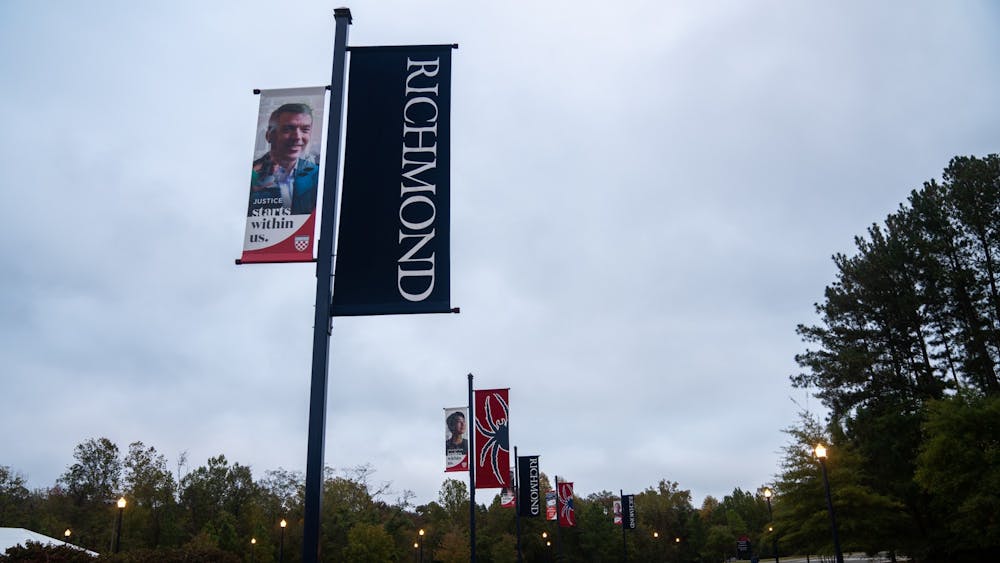Schools across the U.S., including the University of Richmond, use diversity in their marketing to attract prospective students, which is evident in a study that showed that, on average, Black students are overrepresented in college marketing materials by 104%, according to Ted Thornhill's 2018 article, "We Want Black Students, Just Not You: How White Admissions Counselors Screen Black Prospective Students."
The study also noted that leaders of historically predominantly-white institutions argue that overrepresentation of diversity in marketing materials is reflective of university administrations' intentions to be more diverse and to make Black students feel more welcomed.
"It’s a difficult line to tread between misrepresenting the people you have and attempting to make yourself look diverse, because diversity is a pretty important thing when it comes to applying to schools," first-year Zayd Avant said. "It can be difficult when you look at marketing material and you say, 'Okay, they do have Black people here,' and then you go to the school and you see like three Black people a day."
Avant, who is a Black student, is unsure of whether he would want to be a part of a marketing campaign, he said.
"It’s a little bit of a double-edged sword because if I were to be a part of a marketing initiative, I would want for other people of color to know that we exist here on campus and that we’re very supportive," Avant said. "But I also wouldn’t want to feed into that trap that I feel like I fell into a little bit."
Political science professor Monti Datta has been featured in UR marketing initiatives before, including on a billboard, he wrote in an email statement to The Collegian on October 25.
"UR, like many top liberal arts colleges, seeks to create an image of diversity and inclusivity, and so has used image of students, staff and faculty of color, including myself, in building a carefully maintained image," Datta wrote. "I think the challenge is that once this image is portrayed on our website and on marketing materials, how do we live the values we are promoting? This is where I think UR, like a lot of other schools, has some of its best work yet to accomplish."
Datta thinks it is okay for UR to promote diversity, equity and inclusion on marketing materials, but UR has to reflect on whether those same values being promoted are showing up on campus, Datta wrote.
"Last January, for instance, a series of racist and xenophobic incidents affected a good part of the campus community at UR," Datta wrote. "There were powerful events, like the Open Mic session and the Interpoint dialogues, that leaned powerfully into the hard conversations that were needed. But those events were not put on official marketing materials."
Senior Will Walker, a Black student, has been featured in multiple advertisements for UR, he said, including a Spider Spotlight that was posted on UR's Facebook and Youtube accounts in June 2019.
"I think the important thing you have to think about when it comes to colleges is that this is a business," Walker said. "They are at all times selling and promoting the university and a part of that is marketing students to other prospective students."
Walker participated in a shoot for a 2018 Halloween video the school posted on Instagram, but a photograph of him from that was then used in a 2019 Robins School of Business marketing flyer for the Summer Business Institute. Walker is not a Robins School of Business student, he said.
Enjoy what you're reading?
Signup for our newsletter
"What’s upsetting about that is you don’t know exactly where these photos are going to be published," Walker said. "...with our small pool of students of color on campus, there’s a constant push to get new faces, because diversity is a selling point, but that commodifies Black students."
John Barry, vice president for communications, confirmed that once students consent to their photographs being used for marketing, the photos can be used in any advertisement for the school.
"What we would say [to students] is, 'We’re working on this project on the website, but you should know if you chose to participate with us, it’s conceivable we could put that on an ad someday or in a viewbook somewhere, or in any number of ways.'" Barry said. "'But you should never be surprised by that; you should have agreed when you sign on that there is a range of possibilities to exist.'
"We don’t know what we’ll be doing six months from now, so even if I took [a student's] photograph today, it might not even be possible for me to say how I might intend to use that six months from now," Barry said. "But I do have a responsibility to tell you that if you choose to do this, it’s going to go in our library, and then it could show up in a number of different places."
University Communications staff contacts students for marketing initiatives based on those who have shown interest in being featured and recommendations from the deans of the Richmond and Westhampton colleges, Barry said.
"Those names are generally suggested to us, and then we follow up to tell them what we’re planning on doing and how we’re planning on doing it and what we would need from them," Barry said. "Ultimately it’s always up to the students to decide if they want to participate."
The deans suggest students to Communications, but that doesn't mean they're necessarily going to get chosen, Dean Boehman wrote in an email statement to The Collegian.
"There really isn’t a process per se, but I keep track of students I interact with who may have an interest in the project or working group at hand," Boehman wrote. "Sometimes I am asked for a specific representative student, like an A&S sophomore or junior, a rep from the RCSGA, or something like that."
Communications tries not to over- or underrepresent opinions or groups of students, Barry said.
"Obviously, some students are going to have experiences that aren’t consistent with something they may have seen or heard [in our marketing]," Barry said. "From our perspective, [it is] never our intent to mislead our students; it wouldn’t make sense to do that. You don’t want to get students here who aren’t going to be happy and who are going to leave.
"We want students who want to be here and who are good fits and who are going to want to stay — and, frankly, who then are going to graduate and be alums who want to continue to be engaged with the university, to help students get jobs and help us financially."
It is important to contextualize marketing initiatives within the reality of the racial demographics of UR, Walker said.
"I think what [University] Communications should do is work closely with students and multicultural organizations to really think through the framing of diverse faces in publications and admissions posters and things like that," Walker said. "Students of color like to see themselves represented, but where it concerns marketing advertisement is — what is effectively sold in brochures is not what the campus experience is like because critical information about racial demographics and other campus aspects are not present where those images are."
Contact news writer Meredith Moran at meredith.moran@richmond.edu.
Support independent student media
You can make a tax-deductible donation by clicking the button below, which takes you to our secure PayPal account. The page is set up to receive contributions in whatever amount you designate. We look forward to using the money we raise to further our mission of providing honest and accurate information to students, faculty, staff, alumni and others in the general public.
Donate Now



